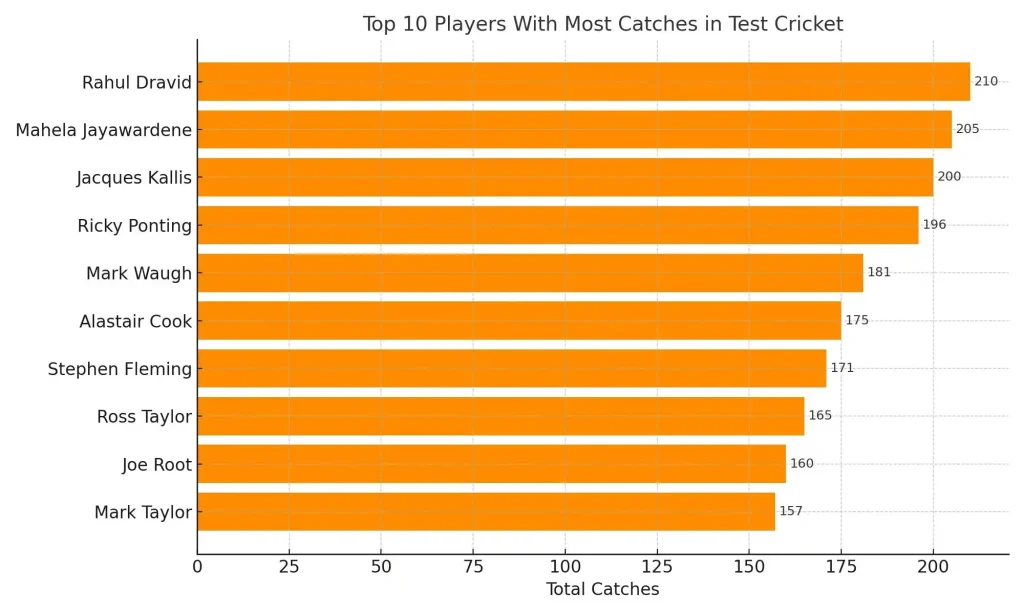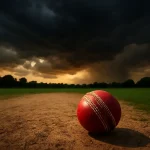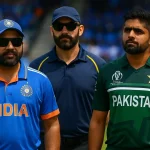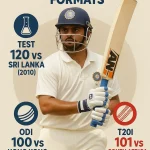
In the long, winding theatre of Test cricket, bowlers are often hailed as the destroyers — the ones who break batting lineups and flip matches. But talk to any fast bowler worth his salt, and he’ll tell you: a spell is only as good as the hands waiting behind the stumps or crouched in the cordon. The most catches in Test cricket isn’t a list of fame-hungry superstars. It’s a roll call of concentration, anticipation, and the kind of cricketing brain that reacts before the ball completes its arc.
These players aren’t just fielders. They’re match-turners in disguise — the ones who make good deliveries lethal and bad ones forgivable. A great slip catch doesn’t just remove a batter — it energizes a team, silences a crowd, and opens the door to chaos. Over five days, those moments add up. And the men on this list didn’t just catch balls — they caught chances, pressure, history.
Top 10 Players With the Most Catches in Test Cricket (As of 2025)
| Rank | Player | Matches | Catches | Average Catches/Match | Position(s) |
| 1 | Rahul Dravid | 164 | 210 | 1.28 | Slip |
| 2 | Mahela Jayawardene | 149 | 205 | 1.38 | Slip/Gully |
| 3 | Jacques Kallis | 166 | 200 | 1.20 | Slip/Gully |
| 4 | Ricky Ponting | 168 | 196 | 1.17 | Slip/Close-in |
| 5 | Joe Root | 143 | 179 | 1.25 | Slip/Short-leg |
| 6 | Mark Waugh | 128 | 181 | 1.41 | Slip |
| 7 | Alastair Cook | 161 | 175 | 1.08 | Slip/Gully |
| 8 | Stephen Fleming | 111 | 171 | 1.54 | Slip |
| 9 | Steve Smith | 103 | 166 | 1.61 | Slip/Short-leg |
| 10 | Hashim Amla | 124 | 164 | 1.32 | Slip/Gully |
The Rahul Dravid Blueprint: Calm Hands, Clear Mind
Dravid topping the most catches in Test cricket list isn’t an accident — it’s an outcome of deliberate training and mental discipline. He wasn’t the most athletic. But he was the most alert. The ball didn’t “come to him” — he read it, anticipated it, absorbed it. Fielding in the slip cordon, especially to spinners like Anil Kumble and Harbhajan Singh, is a nightmare of reflexes. But Dravid stood there for years like a monk, barely blinking, yet always ready.
There’s a moment from the 2004 series against Australia — Kumble tosses it up, Langer edges, Dravid dives low to his right. Not a spectacular dive. But controlled, expected, inevitable. That’s the essence of elite slip catching — it doesn’t look magical because it’s built on repetition. And Dravid, perhaps more than any batter, turned catching into second nature.
Slip Science: Why It’s the Most Demanding Position
Standing in the slips sounds simple — until you’re there. Every batter edges differently. Right-handers, left-handers, high elbows, low punches — every technique sends the ball on a unique path. Add to that late movement off the pitch or in the air, and you’ve got a position that demands not just reflex but geometry.
Most of the players on this list spent their careers reading those angles. Mark Waugh, for instance, had hands like silk and eyes like radar. Kallis wasn’t the most explosive mover, but he understood when to expect edges. Ponting, Root, and Smith? Each one adapted their catching craft to evolving formats and roles — from short-leg to slip to silly point. And none of them treated it as a secondary skill.
Table: Catches by Position – Specialist Slip Fielders (Top 5)
| Player | Slip Catches | Close-in/Other | Total Catches | Matches |
| Rahul Dravid | 185 | 25 | 210 | 164 |
| Mark Waugh | 162 | 19 | 181 | 128 |
| Mahela Jayawardene | 180 | 25 | 205 | 149 |
| Stephen Fleming | 155 | 16 | 171 | 111 |
| Steve Smith | 150 | 16 | 166 | 103 |
Joe Root & Steve Smith: The Modern Masters
What sets Root and Smith apart in the modern game is how they maintain elite standards across formats without sacrificing their slip-catching duties. In an era of T20 knees and flat pitches, standing in slips for 90 overs requires mental resolve. Root, in particular, has become England’s best catcher post-Cook — agile, intuitive, and deceptively fast.
Smith? He’s got a touch of the absurd — catching blinders at short-leg one day, flying at second slip the next. There’s a stubbornness in his game that spills into his fielding. He doesn’t give up on anything — not even half-chances. And in Test cricket, that attitude alone can save 100 runs across a session.

Beyond the Numbers: Why These Catches Matter
Catches don’t just complete dismissals — they multiply momentum. Take the Jayawardene–Muralitharan partnership. Mahela didn’t just pouch chances off Murali — he understood his rhythm. Where the doosra would land. How the batter might react. That sort of synergy can’t be manufactured. It’s built over years. And it creates collapses.
Even outside the top ten, think of fielders like Ben Stokes or Ross Taylor — men who may not top the most catches in Test cricket list, but who’ve held onto match-defining moments under extreme pressure. That’s the silent weight these fielders carry — not just clean hands, but clean timing.
Recap: The Scorecard Never Tells the Whole Story
Like every other sporting discipline, cricket also has its unique characteristics. Surely, there must be some logic behind such rules that govern this intricate sport. For every sporting genre, there are separate categories that require distinct methods of evaluation, and all of them necessitate diverse techniques to be accurately assessed. For instance, when evaluating test cricket, it is pivotal to refrain from incorporating T20 metrics, unlike what critics often infer.
Contrary to what many believe, there is absolutely no need to delve deeper than the surface when your objective is to analyze test cricket. When observing a test match, concentrating any TT glaze on the bowlers is a fundamental mistake. Focus on a specific angle and capture one frame with your camera. Without doubt, one of those stills will feature an individual who brought winner’s glee to the game. Entire sections can be expunged, and even whole games can be ignored. However, whether the test match consists of exceeding ten pre-run sixes paired with a handful of boundaries along with some wickets, goes without saying, it matters in collective ascendance, too.

Meet Arjun Kushaan, a passionate cricket analyst at The Cricket24x7. From street matches in his childhood to competitive college tournaments, cricket has always been a central part of Arjun’s life. With a strong background in data analysis and a natural affinity for numbers, he brings a fresh, analytical lens to the game. At The Cricket24x7, Arjun blends his deep love for cricket with his data-driven approach to deliver detailed insights and well-rounded coverage for fans of the sport.






